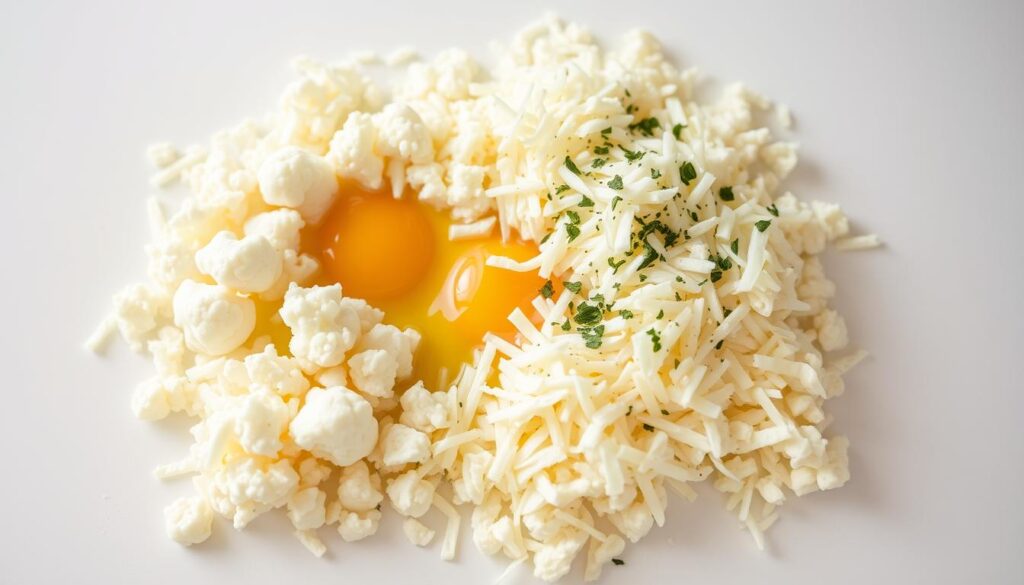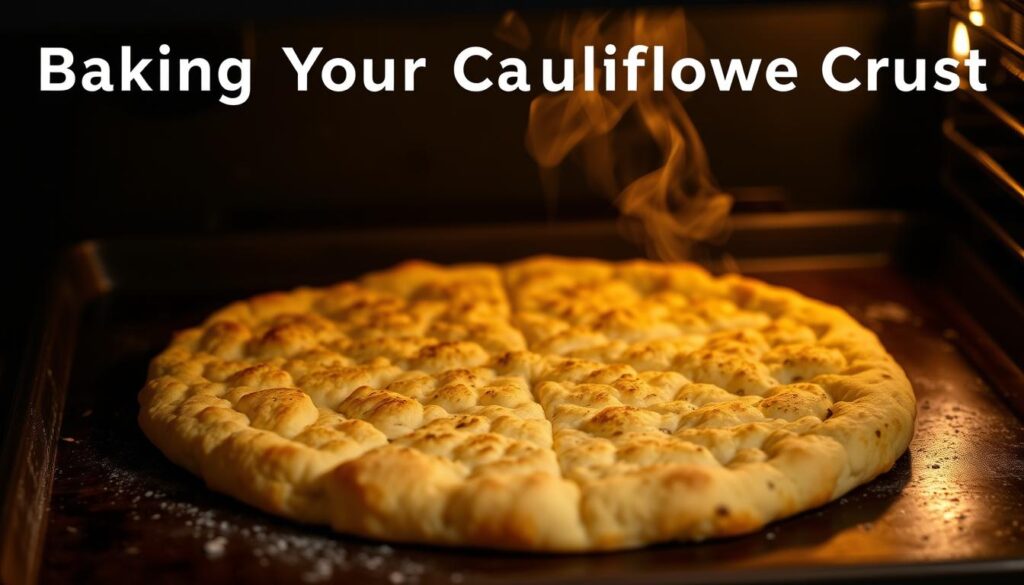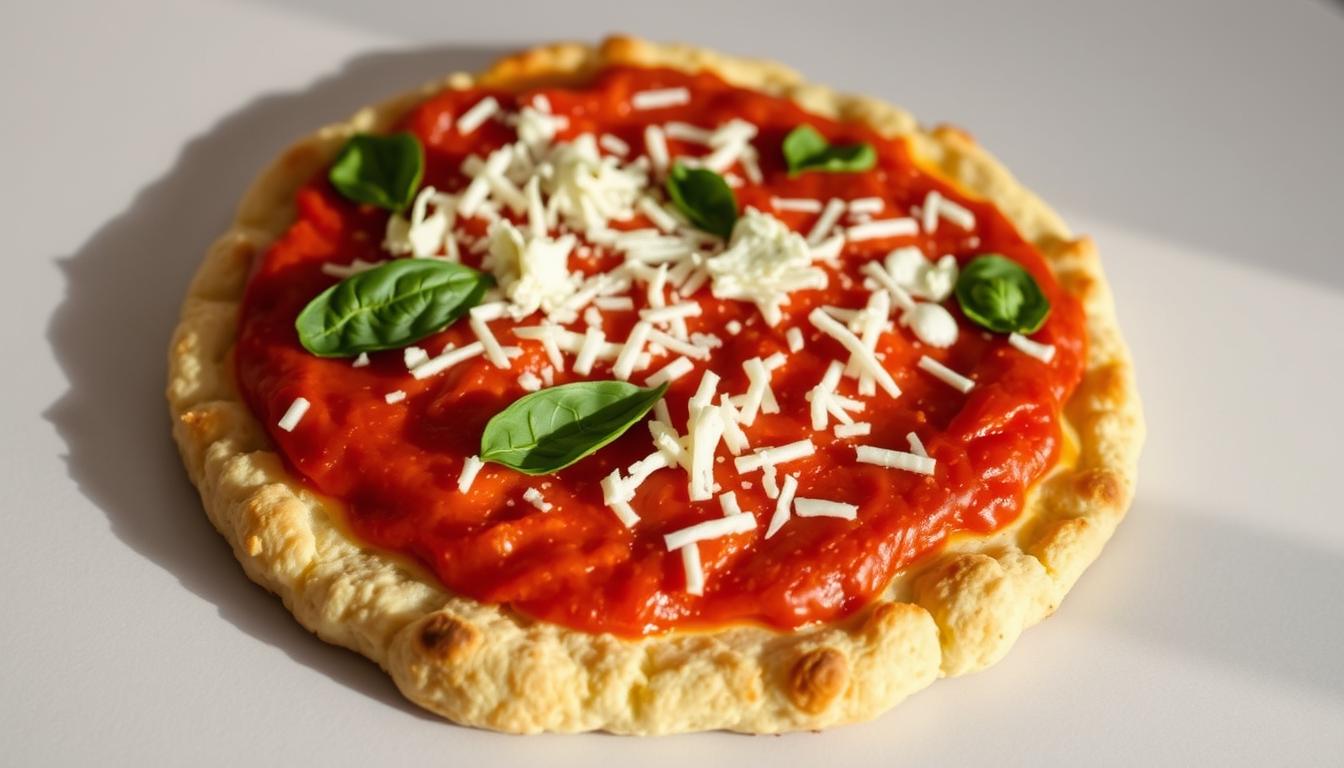Imagine biting into a delicious pizza slice without the guilt of traditional high-carb crusts. The cauliflower pizza crust has changed the game for healthy eating. It offers a tasty alternative that keeps the flavor and texture just right.
This gluten-free pizza crust turns a simple vegetable into a culinary wonder. It will surprise and delight your taste buds.
If you’re on a low carb diet or just want to eat healthier, this cauliflower pizza crust recipe is for you. It’s crispy, satisfying, and full of nutrition. You’ll forget all about traditional wheat-based crusts.
Key Takeaways
- Discover a delicious low-carb pizza alternative
- Enjoy a naturally gluten-free crust option
- Create a nutritious meal in under 30 minutes
- Transform cauliflower into a crispy, satisfying base
- Perfect for health-conscious food lovers
What is Cauliflower Pizza Crust?
Discover a game-changing healthy pizza crust alternative that’s taking the culinary world by storm. Cauliflower pizza crust offers a delicious solution for people seeking low-carb and gluten-free options that don’t compromise on taste.
This innovative crust transforms the humble cauliflower into a nutritious base for your favorite pizza toppings. As a keto-friendly pizza crust, it provides a remarkable alternative to traditional wheat-based crusts, packed with essential nutrients and minimal carbohydrates.
Understanding Cauliflower as an Alternative
Cauliflower stands out as a versatile vegetable that can replace high-carb ingredients in many recipes. Its neutral flavor and adaptable texture make it perfect for creating pizza crusts that satisfy health-conscious food lovers.
- Naturally gluten-free
- Low in calories
- High in essential nutrients
- Supports various dietary needs
Nutritional Benefits of Cauliflower
The nutritional profile of cauliflower makes it an exceptional base for a healthy pizza crust. Rich in vitamins and minerals, this cruciferous vegetable delivers significant health advantages.
- Contains vitamin C and vitamin K
- Provides antioxidants
- Supports digestive health with dietary fiber
- Low in calories and carbohydrates
By choosing a cauliflower pizza crust, you’re not just making a delicious meal – you’re making a smart nutritional choice that supports your wellness goals.
Ingredients You Will Need
To make a tasty homemade cauliflower crust, you need the right ingredients. Your recipe will need a mix of fresh produce and pantry staples. These will turn a simple veggie into a delicious pizza base.
Fresh Cauliflower vs. Frozen Cauliflower
When making your cauliflower crust, you can choose between fresh or frozen cauliflower. Each choice has its own benefits for your crust.
- Fresh Cauliflower:
- Maximum flavor control
- Fresher texture
- Requires more preparation time
- Frozen Cauliflower:
- Convenient and time-saving
- Pre-riced options available
- Consistent moisture content
Essential Seasonings and Cheese Options
The secret to a great cauliflower crust is in the seasonings and cheese. These ingredients not only give structure but also boost the flavor.
| Ingredient Category | Recommended Options | Quantity |
|---|---|---|
| Cheese | Mozzarella | 2 cups (1 cup in crust) |
| Cheese | Parmesan | 1/2 cup (1/4 cup in crust) |
| Seasonings | Dried Oregano | 1 tsp |
| Seasonings | Garlic Powder | 1/2 tsp |
| Binding Agent | Large Eggs | 2 whole eggs |
With these ingredients, your cauliflower crust will turn out amazing. The cheeses add rich flavor, and the seasonings bring depth to your crust.
Preparing the Cauliflower
Making an easy cauliflower pizza crust begins with preparing your cauliflower right. This step is key to the crust’s texture and success. By mastering the right techniques, you can turn this simple veggie into a tasty low-carb pizza base.
Steps for Ricing Cauliflower
To rice cauliflower, you’ll need a food processor or a sharp grater. Here’s how to do it:
- Wash the cauliflower thoroughly
- Cut into small florets
- Pulse in food processor until rice-like texture forms
- Aim for consistent, small granules
If you don’t have a food processor, a box grater is great for making your cauliflower crust base. Professional chefs say using fresh cauliflower is.
Importance of Moisture Removal
Removing moisture is key for a crispy crust. Too much water can make your crust soggy and prevent it from browning well.
| Moisture Removal Method | Time Required | Effectiveness |
|---|---|---|
| Microwave | 8 minutes | Quick and efficient |
| Oven Drying | 10-12 minutes | More even moisture reduction |
| Cheesecloth Squeezing | 5 minutes | Maximum liquid extraction |
After cooking, squeeze out as much liquid as you can with a clean towel or cheesecloth. Press firmly but gently. This will make your cauliflower pizza crust crisp and tasty.
Mixing the Ingredients
Making a homemade cauliflower crust recipe needs careful mixing of ingredients. Your cauliflower crust will turn into a tasty pizza base with the right mix.

Incorporating Eggs and Cheese
Eggs are key to a great cauliflower crust. They help hold everything together. Here’s how to mix your riced cauliflower with eggs:
- Use 1-2 large eggs for every 1-1/2 pounds of cauliflower
- Choose a cheese that melts well, like mozzarella or parmesan
- Add 3/4 cup of shredded cheese to the cauliflower base
“The right combination of eggs and cheese transforms cauliflower into a fantastic pizza crust!” – Professional Chef
Adding Seasonings for Flavor
Seasonings make your cauliflower crust come to life. Here are some great options:
- Garlic powder (1 teaspoon)
- Italian seasoning blend (2 teaspoons)
- Salt and black pepper to taste
Mix all ingredients well in a large bowl. You want a mix that’s moist but not too wet. It should be ready to shape into a tasty low-carb pizza crust.
Shaping Your Pizza Crust
Making the perfect cauliflower pizza crust needs care and skill. You want to turn the cauliflower mix into a tasty, crispy crust. This will wow pizza fans everywhere.
Techniques for Even Thickness
Getting the crust even is key for a great cauliflower pizza. Here’s how to do it:
- Put the cauliflower mix on a lined baking sheet
- Spread it out with your hands
- Make it a circle, about 11 inches wide
- Make the edges a bit thicker to stop burning
Tips for Avoiding Stickiness
Stopping the crust from sticking is tough. But here are some tips:
- Use parchment paper or a silicone mat
- Wet your hands a bit when spreading
- Dry the cauliflower well before mixing
“The key to a crispy cauliflower pizza crust is in the preparation and technique.” – Culinary Expert
| Shaping Technique | Tips |
|---|---|
| Spreading Mixture | Use palm of hand, maintain 1/4 inch thickness |
| Edge Formation | Push edges inward to create slight border |
| Moisture Control | Pat dry with paper towels before shaping |
Remember, the more you make cauliflower pizza crust, the better you’ll get. With each try, you’ll get closer to that perfect crispy crust.
Baking Your Cauliflower Crust
Making a crispy cauliflower pizza crust needs precision and care. The right baking technique turns your cauliflower base into a golden, delicious base for toppings.

To start, preheat your oven to 450°F. This temperature is key for a crispy texture. The first baking stage is important for a strong base that holds your toppings well.
The Perfect Baking Technique
Here are the essential steps for baking:
- Spread the cauliflower mixture evenly on a baking sheet
- Bake for the first 10 minutes to set the base
- Carefully flip the crust using a spatula
- Bake for an additional 7 minutes until golden
Temperature and Timing Tips
Your crispy cauliflower pizza crust needs attention. It usually takes about 17 minutes to bake. Look for these signs of a perfectly baked crust:
- Golden-brown edges
- Firm, dry surface
- Slight crispiness when touched
Pro tip: Pre-baking the crust helps achieve that crisp texture everyone loves. With just 1 gram of carbohydrates per pizza round, this crust is great for low-carb and gluten-free diets.
Customizing Your Pizza Crust
Your cauliflower pizza crust is a blank canvas for creativity. It’s great for those on a keto diet or just looking for a healthier option. With the right toppings and techniques, you can make it into a tasty masterpiece.
Exploring Delicious Topping Combinations
The cauliflower pizza crust is very flexible. You can try many different flavors. Here are some tasty combinations:
- Mediterranean: Feta cheese, olives, spinach, and sun-dried tomatoes
- Protein-Packed: Grilled chicken, bell peppers, and mozzarella
- Seafood Delight: Shrimp, garlic, and fresh herbs
- Veggie Lover’s: Roasted vegetables and herb-infused olive oil
Vegan and Dairy-Free Options
For those on a plant-based diet, cauliflower crust is perfect. Try alternatives like nutritional yeast or cashew cheese. Tofu, tempeh, or chickpeas add protein and texture.
Pro tip: Pre-cook veggies to avoid a soggy crust. Bake at 220°C (440°F) for 12-15 minutes. Then, broil for 2-3 minutes for a golden crust.
Storing Leftover Cauliflower Crust
Making a homemade cauliflower crust is a big job. Knowing how to store it right is key. This way, you can enjoy it later without losing its taste and texture.
Best Practices for Refrigeration
You can keep your cauliflower pizza crust in the fridge for 3-4 days. Here’s how to do it right:
- Use an airtight container to prevent moisture absorption
- Store the crust separately from toppings
- Keep refrigerator temperature below 40°F
- Place a paper towel in the container to absorb excess moisture
How to Freeze for Future Use
Freezing your cauliflower crust is a great way to prep meals. Here’s how to freeze it well:
- Cool the crust completely after baking
- Wrap tightly in plastic wrap or aluminum foil
- Place in a freezer-safe bag or container
- Label with the date of preparation
- Freeze for up to 3 months
To use it, thaw the crust in the fridge overnight. Then, reheat at 400°F for 10 minutes. Add your favorite toppings and bake for 5-10 minutes more until crispy.
Serving Suggestions
Your low carb pizza crust opens up a world of delicious possibilities! After carefully preparing your healthy pizza crust alternative, you’ll want to explore creative ways to serve and enjoy every slice. The versatility of cauliflower pizza crust allows for numerous exciting serving options that can transform your meal experience.
Perfect Pairings and Side Dishes
Complement your cauliflower pizza with light and refreshing sides that enhance its nutritional profile. Consider these delightful pairing suggestions:
- Fresh garden salad with mixed greens
- Roasted vegetable medley
- Greek yogurt-based dips
- Protein-rich egg scramble
Creative Leftover Transformations
Don’t let your leftover cauliflower pizza go to waste! With just a bit of creativity, you can repurpose those slices into exciting new meals. Here are some innovative ideas to breathe new life into your low carb pizza crust:
- Breakfast pizza with sunny-side-up eggs
- Crispy pizza chip appetizers
- Savory pizza croutons for salads
Pro tip: Let your pizza cool for 1-2 minutes before cutting to maintain the perfect texture!
Nutritional Serving Guide
| Serving Size | Calories | Carbohydrates | Protein |
|---|---|---|---|
| 1/4 Pizza Crust | 96 kcal | 6g | 7g |
By exploring these serving suggestions, you’ll transform your cauliflower pizza from a simple meal into a culinary adventure that delights both your taste buds and nutritional goals!
Troubleshooting Common Issues
Making the perfect crispy cauliflower pizza crust can be tough. Even skilled cooks face challenges. Knowing common problems helps you get it right.
Managing moisture is key. Too much water can make your crust soggy. Chefs suggest these tips:
Fixing a Crumbly Crust
A crumbly crust often means not enough binding. Try these fixes:
- Add an extra egg for strength
- More cheese helps it stick together
- Use finely riced cauliflower for a smoother crust
- Press the crust firmly when shaping
Dealing with a Soggy Base
Removing moisture is essential for a crispy crust. Here’s what experts say:
- Squeeze cauliflower rice really well
- Use a clean towel or cheesecloth
- Get rid of as much liquid as you can
- Pre-bake the crust before adding toppings
| Problem | Cause | Solution |
|---|---|---|
| Crumbly Texture | Low binding ingredients | Add more eggs or cheese |
| Soggy Base | Excess moisture | Thoroughly squeeze cauliflower rice |
| Uneven Cooking | Inconsistent crust thickness | Spread evenly, use parchment paper |
Getting better at making cauliflower crust takes practice. Each try teaches you more about managing moisture and getting that crispy texture.
Health Benefits of Cauliflower Pizza Crust
A gluten-free pizza crust made from cauliflower is a healthy choice. It turns traditional pizza into a meal full of nutrients without losing flavor. Compared to wheat-based crusts, cauliflower crust has much fewer carbs, making it great for those watching their carb intake.
Those with dietary restrictions will find cauliflower crust beneficial. It’s perfect for people with celiac disease or gluten sensitivities. They can enjoy pizza without the digestive issues that wheat can cause. Cauliflower crust is also packed with vitamins, including a lot of vitamin C, which boosts the immune system.
Using cauliflower crust can help with weight management. One slice has only 4 grams of carbs, compared to 28 grams in traditional crusts. It’s also high in protein and low in calories, making it a smart choice for those on low-carb diets. This way, you can enjoy pizza while staying on track with your health goals.
Low Carb Advantages for Dieters
Reducing carbs is easy with cauliflower crust. It has 70.8% fewer carbs than whole-wheat crusts, which is good for your metabolism and weight. With just 7 grams of carbs per serving, you can enjoy pizza while sticking to your diet.
Gluten-Free Lifestyle Benefits
For those avoiding gluten, cauliflower pizza crust is a tasty and safe option. Many people see better skin and digestion after cutting out gluten. This grain-free choice lets you enjoy pizza without harming your health or causing inflammation.

